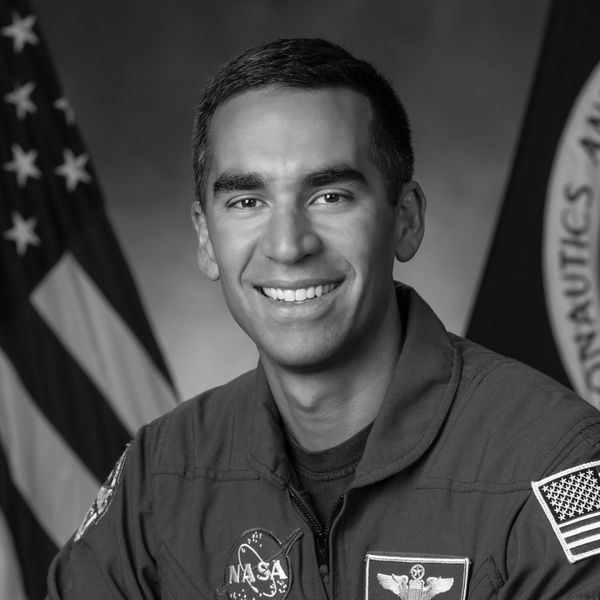Trending Now
We have updated our Privacy Policy and Terms of Use for Eurasia Group and its affiliates, including GZERO Media, to clarify the types of data we collect, how we collect it, how we use data and with whom we share data. By using our website you consent to our Terms and Conditions and Privacy Policy, including the transfer of your personal data to the United States from your country of residence, and our use of cookies described in our Cookie Policy.
{{ subpage.title }}
The future of space: congested and contested
Listen: Space might be a big place but the United Nations regards it as ‘congested, contested and competitive’.
This latest episode of Next Giant Leap, a podcast produced by GZERO Media in partnership with the space company MDA Space, explores the threats and tensions as space becomes busier and of greater strategic importance for an increasing number of countries.
“We have to avoid, by all means, that it becomes a Wild West,” says Tanja Masson-Zwaan, a space law expert at Leiden University in the Netherlands. She adds, “We have regulations, laws and treaties that have been in place for the last fifty years, but we need more to govern this new frontier of space utilization, because the rules that we have are basic principles and do not go into the details.”
Satellites are now being deployed to Low Earth Orbit at a rate of thousands every year. This zone of space is already littered with old defunct satellites and the remains of discarded sections of rockets which have accumulated over more than five decades. The risk of collisions is increasing, raising fears of a runaway cascade of space debris.
Tests of anti-satellite (ASAT) weapons have showered still more debris into Low Earth Orbit. Since 2007, China, the United States, India, and Russia have conducted ASAT tests. Last year the United States announced its own moratorium on ASAT tests and, through a United Nations resolution, it has called for other nations to follow suit. So far China, Russia, and India have not signed up. So is space set to become a new theater for conflict and weapons proliferation?
“Look at how satellites have become embedded in our way of life,” says Kevin Whale, senior director of defense strategy at MDA Space. “If we wreck space, it’s almost one step down from nuclear catastrophe”.
Within a few years, a new phase of the space race will begin. Both the United States and China will be competing to get people to the moon and exploit its resources, particularly water ice in craters at the lunar south pole.
According to Scott Pace, director of the Space Policy Institute at George Washington University, “The Outer Space Treaty says space is the province of all mankind, meaning it's open to usage really by everybody. On the other hand, the principles say we should avoid harmful interference. And so the question is, how do we go about balancing those two imperatives: open to everybody but avoid harmful interference?”

Tanja Masson-Zwaan
Tanja Masson-Zwaan
Deputy Director, International Institute of Air and Space Law, Leiden University
Dr. Tanja Masson-Zwaan is Assistant Professor and Deputy Director of the International Institute of Air and Space Law at Leiden University, and President Emerita of the International Institute of Space Law. She currently also serves as Vice President for Science and Academic Relations of the International Astronautical Federation. Tanja advises the Dutch Government and other institutions on space law issues and was co-founder of the Hague International Space Resources Governance Working Group. She teaches at universities worldwide and is Global Faculty at International Space University.

Scott Pace
Scott Pace
Professor of the Practice of International Affairs, George Washington University
Dr. Scott Pace is Professor of the Practice of International Affairs, Director of the Space Policy Institute, Director of the Institute for International Science and Technology Policy and Director of the MA International Science and Technology Policy program at the George Washington University's Elliott School of International Affairs. His research interests include civil, commercial, and national security space policy, and the management of technical innovation.
Between 2017 and 2020, Dr. Pace served in the White House as Deputy Assistant to the President and Executive Secretary of the National Space Council. He previously served as the Associate Administrator for Program Analysis and Evaluation at NASA from 2005 to 2008 and Deputy Chief of Staff for the NASA Administrator from 2002 to 2003. Prior to his work at NASA, he was the Assistant Director for Space and Aeronautics in the White House Office of Science and Technology Policy.

Kevin Whale Credit: MDA
Kevin Whale
Senior Director of Defense Strategy, MDA Space
Kevin Whale is the Senior Director of Defense Strategy at MDA Space. In collaboration with business area leaders and teams, Kevin leads the development, adaptation, and execution of MDA’s pan-corporation global defense marketplace strategy for business advancement.
Brigadier General (retired) Whale served in the Royal Canadian Air Force for 36 years achieving flight qualifications on Kiowa, Twin Huey, Griffon, and Apache helicopters delivering tactical aviation mobility, reconnaissance, and aerial firepower effects to Joint warfighters. In 2017 he transitioned to space capabilities force development, readiness, and operations leading the Canadian Armed Forces Joint Space program and then as an exchange officer with the US Space Force.

Kevin Fong. Credit: Anthony Cullen
Dr. Kevin Fong (host)
Professor, Department of Science, Technology, Education and Public Policy (STEaPP) at University College London
Kevin Fong is a senior emergency care physician and anesthesiologist in the UK’s National Health Service. He is also an expert in space medicine and has worked as a researcher in NASA’s human spaceflight program in Houston. He is also a broadcaster who has hosted many radio and television shows, and podcasts on space flight and exploration. They include the BBC hit podcast ‘13 Minutes to the Moon’.
- The satellite revolution in Low Earth Orbit ›
- The Graphic Truth: Space junk — enter the trashosphere ›
- Next Giant Leap: New frontiers and the business of ... - GZERO Media ›
- Mission to the Moon, with Artemis II astronaut Jeremy Hansen ›
- Can the US stay ahead of Russia & China in the space race? - GZERO Media ›
- Mark Kelly on the new space race - GZERO Media ›
The satellite revolution in Low Earth Orbit
Listen: In the last twenty-five years, the number of active satellites orbiting the Earth has increased from about 500 to 8,000. “In the first quarter of this year, we deployed nearly 1,000”, says space industry analyst Carissa Bryce Christensen. She adds, “Instead of a smaller number of very large satellites mostly far away, we are seeing many, many small satellites very close in.”
The latest episode of Next Giant Leap, a podcast produced in partnership between GZERO and the Canadian space company MDA, explores the exponential increase in satellites that are being launched into Low Earth orbit (LEO). This is the zone of space between about 100 and 1200 miles above the Earth.
By the end of the decade, MDA’s Chief Executive Officer Mike Greenley predicts there will be tens of thousands of LEO satellites. Many of them will be the component parts of vast satellite constellations, such as the Starlink network, offering broadband internet. Others will be providing the services which the modern world has come to depend upon: GPS navigation, defense and security reconnaissance, weather forecasting, and remote environmental monitoring. For example, Earth Observation satellites are now the most important source of information on the pace and impacts of climate change.
Our satellite eyes in low Earth orbit have become extremely sensitive, according to Professor Martin Sweeting, founder of the UK company Surrey Satellite Technology Ltd. Some of them are now able to resolve objects less than one foot in size from hundreds of miles above. Artificial intelligence is now being harnessed to process and interpret the vast amounts of data gathered by the new generation of satellites.

Carissa Bryce Christensen. Credit: BryceTech
Carissa Bryce Christensen
Founder and Chief Executive Officer, BryceTech
Carissa Bryce Christensen is the Chief Executive Officer and founder of BryceTech companies in the US and the UK. She previously co-founded defense company The Tauri Group and quantum computing software company QxBranch. Ms. Christensen is an internationally recognized expert on the satellite and space industry, known for rigorous analysis and innovative, data-driven strategy. She co-chairs the World Economic Forum Global Future Council on Space, and chairs the US board of the UN-affiliated Space Generation Advisory Council.

Mike Greenley. Credit: MDA
Mike Greenley
Chief Executive Officer, MDA
Mike Greenley has been the Chief Executive Officer of MDA since 2018. Founded in 1969, MDA is an international space mission partner and a robotics, satellite systems and geointelligence pioneer. Mr. Greenley oversees more than 2,700 employees across Canada, the United States and the United Kingdom. Mr. Greenley has over 25 years of experience in the defence and security business. Mr. Greenley is the Vice-Chair of Space Canada and recently served as the Vice-Chair of the Government of Canada’s Economic Strategy Table for Advanced Manufacturing.

Professor Sir Martin Sweeting
Professor Sir Martin Sweeting
Founder and Executive Chairman, Surrey Satellite Technology Ltd
Professor Sir Martin Sweeting pioneered rapid-response, low-cost and highly capable small satellites, utilizing modern consumer electronics devices to change the economics of space. He is widely regarded internationally as the ‘father’ of small satellites which have changed the nature of the space industry. He is distinguished professor of space engineering at the UK’s University of Surrey. In 1985, he founded the university spin-off company, Surrey Satellite Technology Ltd which has designed, built, launched and operated in orbit nano, micro and mini-satellites for communications & Earth observation, as well as navigation payloads for the European Galileo constellation. Sir Martin is Fellow of the UK Royal Society and the Royal Academy of Engineering.

Kevin Fong. Credit: Anthony Cullen
Dr. Kevin Fong (host)
Professor, Department of Science, Technology, Education and Public Policy (STEaPP) at University College London
Kevin Fong is a senior emergency care physician and anesthesiologist in the UK’s National Health Service. He is also an expert in space medicine and has worked as a researcher in NASA’s human spaceflight program in Houston. He is also a broadcaster who has hosted many radio and television shows, and podcasts on space flight and exploration. They include the BBC hit podcast ‘13 Minutes to the Moon’.
- The Graphic Truth: Space junk — enter the trashosphere ›
- Next Giant Leap: New frontiers and the business of ... - GZERO Media ›
- Mission to the Moon, with Artemis II astronaut Jeremy Hansen ›
- Amazon satellites and Project Kuiper: next steps in Big Tech space race ›
- The future of space: congested and contested - GZERO Media ›
Artemis and the lunar economy
Listen: There is a big difference between NASA’s current Artemis program and its Apollo program of five decades ago. This time, there is a long-term plan for humans on the moon. “We don't want to just touch it and come back and say we're done. We want to go there and stay there,” says NASA astronaut Raja Chari. He adds, “To do that, we need to go where there's resources.”
In the latest episode of Next Giant Leap, a podcast produced in partnership between GZERO and Canadian space company MDA, Raja Chari tells host Kevin Fong that the most valuable known resource on the moon is water ice, which could be used to sustain life in lunar bases. Water ice is most abundant in craters around the moon’s south pole. NASA is enlisting commercial companies such as SpaceX, Astrobotic Technology, and MDA to help get its astronauts to the polar region and in a position to ‘live off the land’ there.
One of MDA’s chief contributions to the Artemis program will be the robotic arm on a space station called the Gateway, which will orbit around the moon. The Gateway will be a transfer point for crew and cargo traveling to and from the lunar surface. MDA’s Holly Johnson is confident that the commercial space sector will be an essential enabler of the vision of a sustained human presence on the moon.
For a deeper dive into the private space industry’s part in the return to the moon, Kevin talks to Chad Anderson of venture capital firm SpaceCapital. Anderson explains why people are now talking about the rise of a ‘lunar economy’. He says, “Who controls the early infrastructure is set to control things and make a lot of money.”

Chad Anderson. Credit: David Noles
Chad Anderson
Founder and managing partner of SpaceCapital
Chad Anderson is the founder and managing partner of Space Capital. Space Capital is a seed-stage venture capital firm which invests in companies developing new space technologies. He is author of The Space Economy: Capitalize on the Greatest Business Opportunity of our Lifetime. Prior to founding Space Capital, Anderson led a successful career at JP Morgan Chase, where he managed a $50-billion real estate portfolio through the Great Recession. He has an MBA with a focus on entrepreneurship and innovation from the University of Oxford.

Raja Chari. Credit: NASA
Raja Chari
NASA Astronaut
Raja Chari was selected as a NASA astronaut in 2017. Prior to joining the space agency, he was a colonel and a fighter pilot in the United States Air Force. In 2021, Raja Chari made his first flight into space. He commanded the mission of a SpaceX Dragon capsule to the International Space Station. Raja Chari then spent almost six months aboard the space station as a mission specialist, which included two space walks. His next mission could well be an Artemis moon landing.

Holly Johnson. Credit: MDA
Holly Johnson
Vice President of Robotics and Space Operations, MDA
Holly Johnson was appointed vice president for robotics and space operations at the Canadian space company MDA in 2022. She is a trained mechanical engineer who has occupied engineering, business development, and corporate operations roles in her 15-year career at the Canadian company.

Kevin Fong. Credit: Anthony Cullen
Dr. Kevin Fong (host)
Professor, Department of Science, Technology, Education and Public Policy (STEaPP) at University College London
Kevin Fong is a senior emergency care physician and anesthesiologist in the UK’s National Health Service. He is also an expert in space medicine and has worked as a researcher in NASA’s human spaceflight program in Houston. He is also a broadcaster who has hosted many radio and television shows, and podcasts on space flight and exploration. They include the BBC hit podcast ‘13 Minutes to the Moon’.
- Next Giant Leap: New frontiers and the business of ... - GZERO Media ›
- Mission to the Moon, with Artemis II astronaut Jeremy Hansen ›
- The Politics of the Moon Mission ›
- Chinese space probe begins drilling on Moon ›
- Amazon satellites and Project Kuiper: next steps in Big Tech space race ›
- Welcome to Antarctica: A conflict-free zone - GZERO Media ›